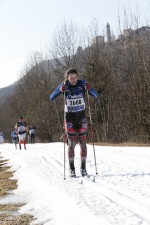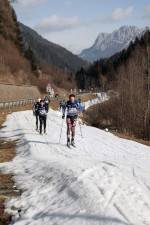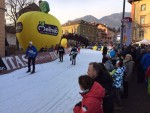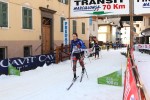
Along every crest, turn and downhill of the course, fans greeted us with cheers of “Bravi! Bravi!” But every so often I swore I could hear strangers cheering my name. Maybe I was getting delusional from fatigue? My name, if mispronounced, does sound similar to the Italian cheer. Then I heard a woman screaming “Travis! Travis! America! America!” Out of eight thousand people, I was one of only 12 Americans to do the race. It turns out I was a bit of a novelty. In a race rivaled in fame only by the Birkebeinerrennet and the Vasaloppet, how could there be so few of us?
Translating as “The Long March,” the Marcialonga is a 70-kilometer classic-only ski race held in Trentino, a mountainous province in the northern part of Italy. Like many people my fascination with the Marcialonga came from watching the Ski Classics race series. While all of these races feature beautiful scenery, the Marcialonga stood out. The thought of skiing through picturesque villages in the Dolomites held particular charm. It’s a race that has been on my bucket list for years. And after seeing the race reduced to 57 k last year due to a lack of snow I knew I shouldn’t wait any longer.
The first challenge is gaining entry to the race. Online registration opens in October but fills up within minutes, but that’s because by that point very few entries remain. The race organizers give allotments of entries to several tour group listed on their website. Signing up with one of these tour groups appears to be the only way to guarantee entry into the race. (Although I did talk with a Canadian couple who said some hotels also get allotments of start numbers.)

Entries unused by the tour companies are returned to the race and made available in October. All of the tour companies are located in Norway and Sweden, which becomes clear why once you’re there. Thousands of Scandinavians descend upon Trentino to do the race. You’d swear that you were in Lillehammer by the sheer number of Norwegian flags hanging from hotel windows — including one that (somewhat annoyingly) hung from our own balcony.
Most of the tour companies were not willing to help those from outside their country, but Norway’s Maxpulse agreed to put a customized package together for us. The thought of being part of a tour group didn’t appeal to me — I took pride in figuring out how to do the Vasaloppet and Birken on my own. But after the experience I appreciate how nice it is to have the logistics taken care of for you. We arranged to meet the Maxpulse group at the Verona airport three days prior to the race. As part of the package they arranged for our accommodations as well as travel from Verona by tour bus. Everyone else in the Maxpulse group (300 in all!) flew in on charter flights from Norway. I’m guessing the Verona airport doesn’t normally see six flights from Oslo every day, but it did the day we arrived. Maxpulse offered several options for places to stay in several towns. We opted to stay at one of the hotels in Cavalese that was conveniently just 200 meters from the finish line.
Before the race Maxpulse organized two ski trips in the area. Two days prior they bused us up to Passo di Lavazé, a nordic trail system with spectacular views of the Dolomites. Normally there is over 80 k of groomed ski trails, but due to the lack of snow only two of the trails were open. It may have been just as well as the temptation to ski too much before the race would have been hard to resist. Maxpulse provided waffles and a warm currant juice that hit the spot after some easy skiing on a bluebird day.
(Story continues below)
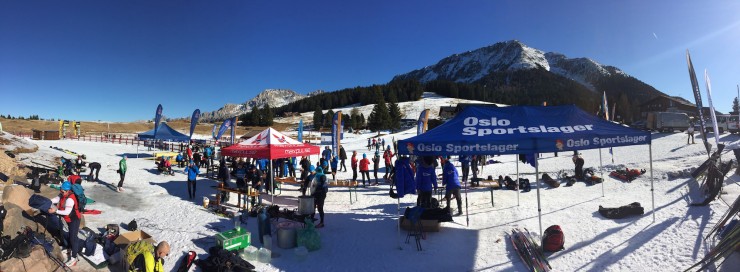
The next day included a trip to the World Cup stadium in Val di Fiemme for testing skis. The stadium is also the start for the final stage of the Tour de Ski, which finishes with the notorious climb up to Alpe Cermis. On our own we took the gondola up Alpe Cermis to see the climb in person. The TV screen doesn’t come close to showing the size or steepness of this monster. Imagine skiing up a blue slope at your local downhill resort and you’ll get the idea.
Maxpulse also took care of all of the logistics related to the race, including registration and travel to/from the start/finish lines. They also had wax techs from Oslo Sportslager, a Norwegian sports store, to prep your skis (for a price) and a wax table and tools if you want to do it yourself. They also had an aid station at the bottom of the final climb to Cavalese to give your kick wax a much-needed touchup. Being able to get on a tour bus, be driven to the start, and then have a place to stay warm prior to the race was fantastic — far superior to the hours I’ve spent freezing while standing around outside before other races.
Like last year a paucity of snow provided a challenge to the race organizers, but this year they were able to put together then entire course. The Italians are famous for their snowmaking, but it’s still impressive to see a 70 k long white stripe of manmade snow that runs along an otherwise brown valley. Each day we watched a seemingly endless procession of trucks carting in snow for the course. No praise is too high for the race organizers pulling this off.
The race course starts in the small town of Moena. Upon arrival by tour bus it becomes clear why in part the race organizers wanted most participants to come with a tour group. The small parking area was lined with tour buses. Despite the congestion it wasn’t difficult to get to the start area and test your skis. The start of the race is the most civilized I’ve experienced in a large race. Skiers are placed in “bins” prior to the race based upon your seeding. You wait in your bin with skis off. When it is your bin’s turn to start, you walk out into the starting area, put your skis on, and go when you’re ready. Thanks to a chip in your bib, your personal race time starts when you cross the start line. Starting this way meant you didn’t have to worry about broken poles or being stuck in the back of your wave.
The start of the race is the most civilized I’ve experienced in a large race.
Important note: Be sure to do a qualifying race so that you get a reasonable start position. Like other Worldloppet races, the Marcialonga is rather strict. Unfortunately the only race they accept as a qualifier stateside is the American Birkie classic race. Also, it has to be the year prior. Even if you don’t plan to race your best effort, starting with skiers of your own ability is huge. Despite having 8000 participants, the Marcialonga never felt crowded because, even though there were at most three sets of track, I was largely with skiers of my own ability. Years ago I got stuck in the back of the Vasaloppet and, despite starting with 16 lanes of track, I spent the entire race weaving in and around skiers. It was hell.
The first 18 k of the Marcialonga consist of a gradual (1 percent average grade) climb up to the town of Canazei. The course winds along the western side of the Val di Fassa valley, with occasional short climbs and descents along the way. After Canazei the course descends on the eastern side of the valley back to Moena then continues on to Predazzo, which is the finish point for the 45 k “light” race. The course continues down the Val di Fiemme valley, passing through the World Cup stadium on the way to the town of Molina, the lowest point of the course at the 64 k mark. The meat of the course, roughly 50 k, is a gradual downhill and perfect for double poling. After Molina you turn around and head back up the valley. The last 2.5 k of the race is the legendary Cascata climb to the finish line in the town of Cavalese.
This year’s Marcialonga will be remembered as one of the slowest because of the difficult snow conditions. When the race started it was overcast and temps just above freezing — perfect violet klister conditions, if you’re out skiing alone that is. Even near the front of the race, skier traffic quickly broke down the tracks. Uphills were churned to sugar and even short downhills were scraped down to the ice below. Thankfully none of the hills, up or down, were particularly long or difficult. A few hours into the race the skies cleared and the temps climbed to +10C (50°F). Once the sun was on the course it was pretty much reduced to slop that was slow to push through. Violet klister was no longer working either, making for some seriously slow double poling.
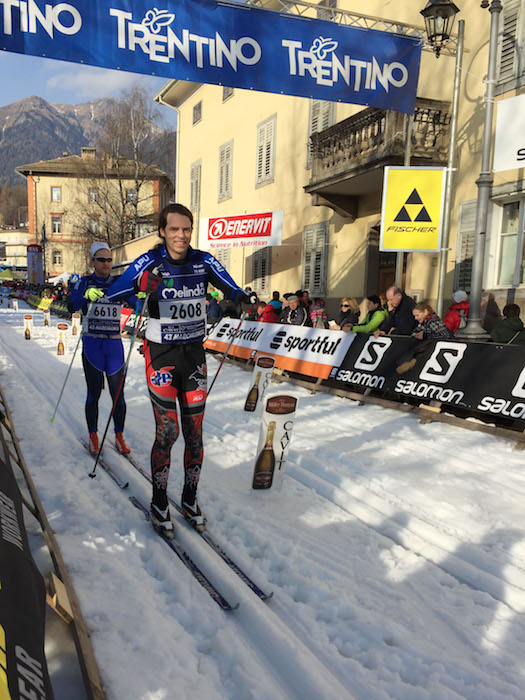
Fortunately for me I was through the high point of the course before I lost kick. I was able to double pole most of the course from Canazei to Molina. A lack of kick wasn’t too much of a problem on the steeper uphills because they frequently turned into a “conga line” of skiers anyway. The biggest challenge was often just keeping your skis pointed straight, as the tracks were erratic or gone. The hardest part of the race was the 4 k from Molina to the start of the Cascata climb. Navigating this gradual uphill without kick after 50+ k of double poling was brutal. The Maxpulse folks touched up my klister, giving me just enough kick to get up the climb and to the finish. My time was about an hour slower than I had expected, but veterans of the race reported being one to two hours behind their best times.
But if you’re doing the Marcialonga to ski fast you’re missing the point. The course is to be savored, as it winds along a picturesque countryside from one charming town to the next. Skiing through these villages, with crowds cheering and the town church’s bell ringing, are among the experiences that make the race special. The aid stations had the typical allotment of oranges and energy drink. But they also had plates heaping with chocolates, cookies, and other treats. And if you wanted a shot of espresso to get you going, some of the aid stations had that too. In the background of it all is the jaw-dropping expanse of the Dolomites.
The highlight of the race is the Cascata climb, where the crowds and adrenaline power you up to the finish line. I won’t pretend I was happy or comfortable the entire race, but by the end I knew I had done something special.
After the race was special too. The town of Cavalese hosted an outdoor party near the finish line, meaning that finishers were met with cheers even as they trickled in well after darkness. The evening concluded with a delightful fireworks display. The next day Maxpulse bused us back to Verona and we racers went our separate ways.
I won’t pretend I was happy or comfortable the entire race, but by the end I knew I had done something special.
As global warming makes winter snow less reliable, ski races will be more prone to being shortened or canceled. This year demonstrated that the Marcialonga’s organizers were able to hold a race, even in adverse conditions, thanks to their prodigious snowmaking abilities. So if you want to do the race, be sure to plan early to get a start number. Be sure to bring sunscreen, as you might need it more than a hat. Don’t forget to say “Grazie mille” to the volunteers at the aid stations. And don’t forget to bring an American flag.
About the Author: Travis Rector is a physics and astronomy professor at the University of Alaska-Anchorage and a longtime member of the Alaska Pacific University ski program. In late January, he was one of 12 Americans to race the Marcialonga, a 70-kilometer classic race in the Province of Trento, Italy.

